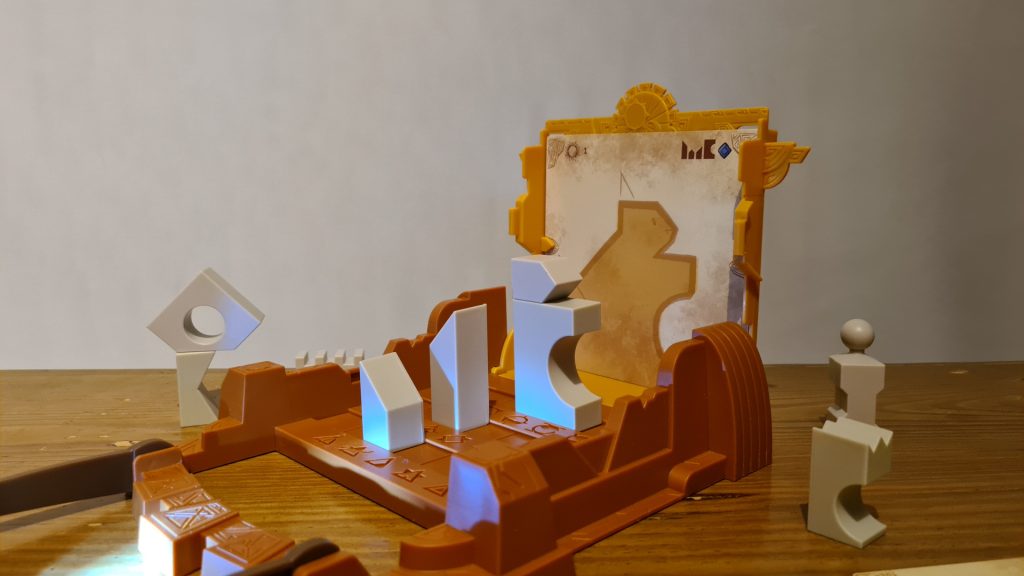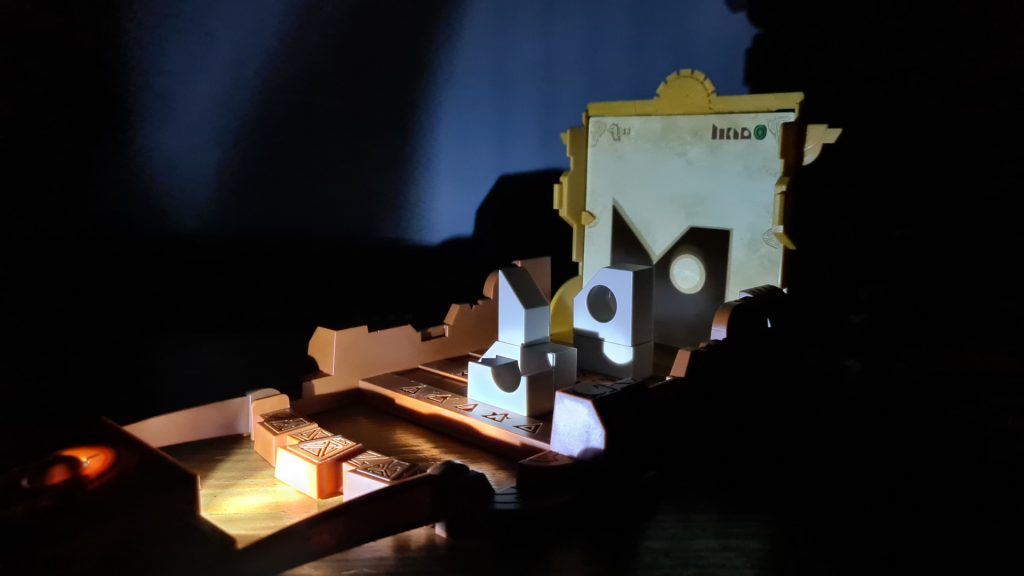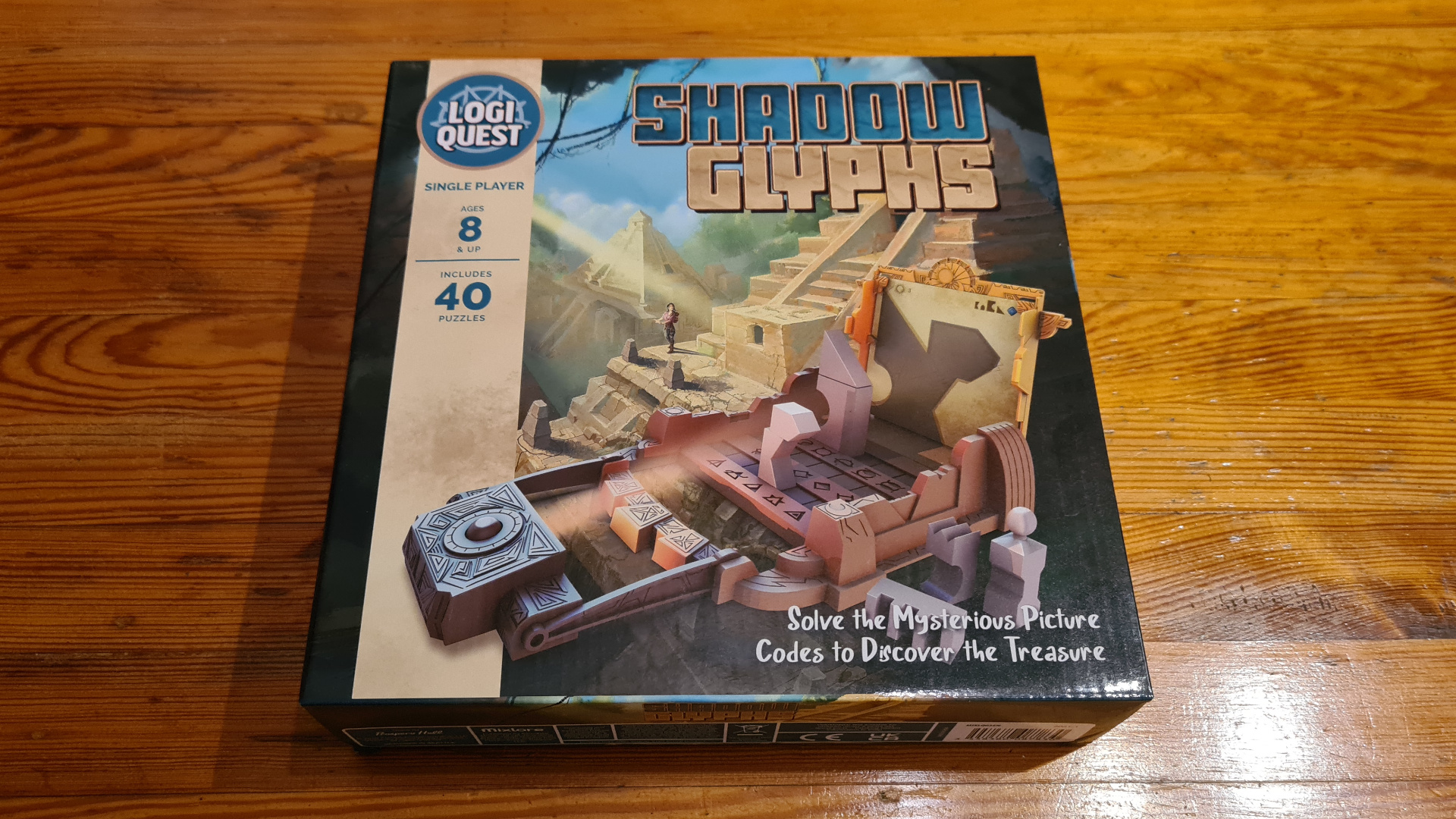Shadow Glyphs is the brand new puzzle game from Mixlore, being one part of the Logiquest product range. This abstract puzzle revolves around light and more importantly, as the name suggests, the shadows cast. Predominantly sold as a single player experience, Shadow Glyphs sees the player in the heart of the jungle. With temples to explore players must use shadows to their advantage, in order to decipher the mystery. However, will you want to continue exploring or will you just feel lost? Let’s find out!
Unfolding the playboard and selecting a puzzle card is the extent of setup, at least after the first play – where you need to insert two AAA batteries. Each puzzle card is part of a temple, with 6 puzzles to solve with each temple – across 3 double sided puzzle cards. For the first 5 puzzles of each temple the player takes the blocks shown on the puzzle card. Then, the player is ready to build. Each temple’s final puzzle card, the Treasure Puzzle, won’t denote any puzzle blocks – instead they will have been indicated by completing the previous 5 puzzles of the temple.
The playboard unfolds from the light to the wall, where the cards are placed. The middle area is where the blocks are placed. Made up of three glyph rows and five flagstone columns, these are where the player can add the blocks in various rotations and orientations. Using only the indicated blocks the player is trying to add the puzzle pieces together so that the shadow cast matches the shape on the puzzle card. The catch is that this build phase is done with the light off! To work out if you solved the puzzle is as simple as turning on the light. As the handy flow chart in the rules explains, if the shadow matches the wall pattern then you solved it!
If not then the player is allowed to adjust the blocks. With the light still on the player is allowed to move the floor blocks left or right, such that they don’t cross more than one flagstone line. Note that they cannot move from one glyph row to another (forwards / backwards). They may also adjust raised blocks such that they stay touching the same blocks. It’s not game over at this point if the puzzle still isn’t solved – though the sun sets with the light turned back off – effectively resetting to the build stage.

Once a puzzle is complete the player can flip the puzzle card over to move onto the next challenge, at this time they can also record their score and the indicated temple clue. Each of the 5 standard puzzle cards have a small star icon somewhere on the design. This will indicate a particular puzzle piece as the clue. This can be recorded on the tracker card, for the player to use during the Treasure Puzzle – the sixth puzzle of the temple. Completing a Treasure Puzzle finds a magic item, which you can use later in your run through the temples to keep the light on, freely move a block with the light on and more.
A scoring system is there if you wish to see how well you do or to compare to others. This awards points based on the number of days that it took you to solve the puzzle, where the days are determined by the number of times the light was turned on. It’s a fairly easy system to use and track, with simple tallys doing the trick. Given enough time or other puzzles, players can even go back and try to improve their scores. Helpfully players aren’t left truly in the dark if they get stuck. In the rulebook there are the solutions to all 48 puzzles. Alas, there isn’t a quick way to check the blocks selected for a Treasure Puzzle are correct before attempting a puzzle without confirming the previous 5 puzzles or seeing the puzzle’s solution.
For the first few puzzles one of the biggest challenges is to get a grasp on how close an object needs to be to the light in order to cast a shadow of the appropriate size. While there are 3 distinct rows and 5 columns to place the variously shaped pieces it is often a surprise how big or small the shadow is compared to what you perceived it might be. The experience starts off with easier puzzles, denoted by a four stage difficulty rating. These allow the player to get those basics before the challenge isn’t just sizing, with it obvious where to place pieces. It becomes about sizing, placement, rotation and occasionally balancing.
The puzzles certainly do increase in difficulty as you work through the 48 unique shadow glyphs. This both sounds like a lot of puzzles and not an endless amount at the same time. Everyone will get the hang of the shadow casting at different rates, though this easily provides a few hours of prolonged puzzle solving. However, players are more likely to work through the 8 temples individually. Solving the Treasure Puzzle at the end of each is a natural pause point, with a sense of satisfaction.

The game can be played and paused in any way though, there is no reason to stop, nor is there a necessity to play a predetermined number of puzzles in one sitting. This is thanks to the included tracker card, which lets players save their score and remember the indicated puzzle blocks in solved puzzles. As puzzle pieces are often used in multiple puzzles back to back, this tracker card is key to not forgetting those indicated for the upcoming Treasure Puzzle.
While it is possible to solve the puzzles as a couple or a group this can run into the issue of “too many cooks”, if too many differing opinions keep cropping up. With the way to record scores, the number of days used to solve the puzzle, players can compete. Regardless, Shadow Glyphs feels very much like sitting down with a puzzle book of old and trying to test yourself as a solo experience.
Production wise Shadows Glyphs does a great job. The design makes it intuitive of how to play. It’s obvious that the playboard unfolds and sets the light at an exact distance away from the block building rows. The blocks are clear, distinct shapes – even two that are similar can be distinguished in the iconography. There’s a couple of hooks that the puzzle cards slide down behind keeping them upright, making the only issue players face is solving the puzzles themselves. Then, when done solving some puzzles the playboard itself, with the wall and light, folds down and away easily to pack into the box.
Shadow Glyphs is a rather unique puzzle experience, yet one that is instantly understood and enjoyed – even when it causes puzzled head scratching and frustration. There is the potential that it could leave others around the table left unable to join in, but it is a great way to pass some solo time. The production quality does that game justice and allows it to simply hit the table, unfold and the player to dive into the temples. Shadow Glyphs is one part of the new Logiquest range from Asmodee, with each offering a puzzle solving like experience. If the rest of the range offers an experience like this then I cannot wait to get hands on with them too!
(Editor’s Note: Shadow Glyphs was provided to us by Asmodee for the review. The game is currently available from local board game stores! Find your local store here.)

